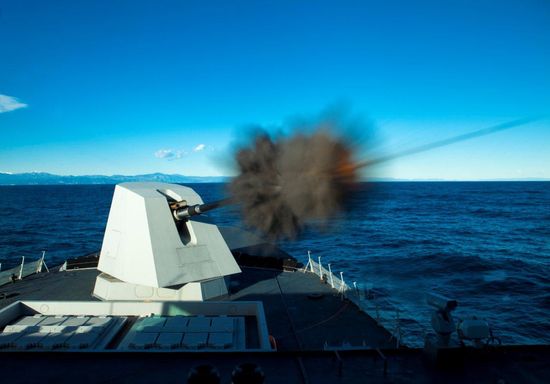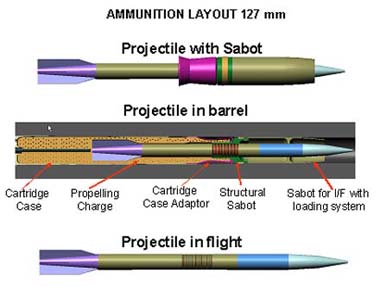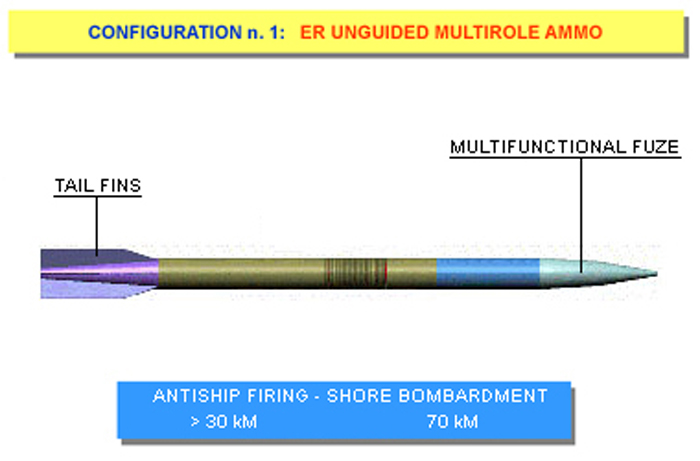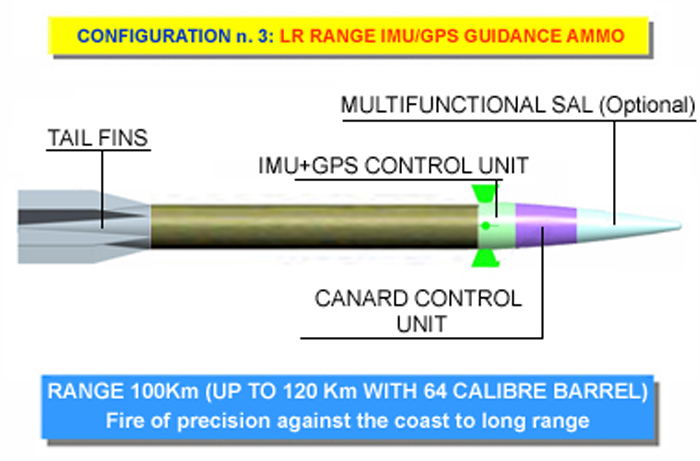| Vulcano
This is a fin-stabilized projectile and
is essentially the OTO-Melara competitor to ERGM
and BTERM, but the initial version does not use rocket boost and will
be unguided. Greater range is to be achieved by increasing the muzzle
velocity, which may reduce the barrel life. OTO-Melara states that
Vulcano can be used by both Compact and LW mountings. Rounds will
be sub-caliber with a sabot.
As of July 2011, OTO-Melara plans three
versions of this munition. Using the standard 54 caliber barrel,
these will be of the following types and ranges:
- Unguided multipurpose
round with a ballistic range of about 38 nm (70 km)
- Terminally guided
round with an on-board IR seeker intended for anti-ship engagements up
to 38 nm (70 km)
- Inertially guided
system with GPS for the NSFS role and a maximum range of about 54 nm (100
km)
Using the new 64 caliber barrel will increase
these ranges by approximately 20 percent.
The Italian Army has decided to participate
in the development of these munitions with the result that 155 mm versions
will also be produced for the first and third variation. The main
difference in the land versions, apart from the caliber, is the propelling
charge configuration which has been specifically designed for compatibility
with the PzH2000's loading system.
Rounds with GPS and INS guidance are expected
to achieve a CEP of less than 66 feet (20 m). The NSFS and 155 mm
munitions will include a laser-seeker.
Quoting from "Long Shots" by Bill Sweetman:
According to Oto-Melara, the Vulcano
program intends to provide warships with the capability to perform long-range
precision bombardment against area targets with a radius of more than 250
meters (such as a tank company or a logistics installation), against point
targets with a radius of around 100 meters (a brigade command post), and
against precision targets (10-meter radius) such as bunkers or vehicles.
For this mode, Vulcano rounds will start
a GPS/IMU (inertial measurement units)-controlled glide 60 sec. after firing,
when they are 50 km. downrange and at the 18-km. apogee of their ballistic
trajectories. They will perform a GPS/IMU-controlled terminal top-attack
when above the target. The glide phase will typically last 140-230
sec.; the terminal attack phase 10 sec.
Oto-Melara also plans to equip a Vulcano
variant with an infrared terminal seeker, providing long-range, precise
anti-surface warfare capability against naval targets, including small
fast-patrol boats. In this version, the Vulcano round starts looking
for the target when overhead at an altitude of 2,500 meters (8,200 ft.).
In both modes, the rounds carry a pre-fragmented semi-armor-piercing warhead.
System design requirements include a maximum
effective range of 70 km. for the unguided munition, 100 km. for guided
munitions fired from the 54-caliber gun, and 120 km. for guided munitions
fired from the 64-caliber gun. Accuracy is said to be better than
20 meters; payload performance is designed to deliver 100 kg. (220 lb.)/min.
over a 1-hr. sustained period, 200 kg./min. over a 3-min. period and 300
kg./min. over a 10-sec. salvo.
The Vulcano concept is based on a fin-stabilized
projectile without rocket assistance. Range enhancement is achieved
by greater muzzle velocity and improved aerodynamics compared with a full-caliber
shell, Oto-Melara says. The Vulcano rounds will be compatible with
existing loading systems (although the 127-mm./54-caliber Compact operated
by the Dutch and the in-service Italian ships need minor modifications).
So far, live-firing tests show that the
airframes designed for the Vulcano extended and long-range rounds create
no anomalous wave pressures and have "good average muzzle velocity" of
1,070 meters/sec., Oto-Melara claims. Ranges of more than 48 km.,
with the apogee point at a range of 27.5 km. and an altitude of 10,500
meters (34,500 ft.), were achieved using a gun elevation of 33.5 deg.
Wind-tunnel tests in Germany in 2006 looked at two designs for the canards
that are used to control the round in its terminal phase, and tested the
control actuation section under realistic pressure conditions.
In November 2011, OTO-Melara announced that
the unguided ballistic version (BLR) would complete flight testing in 2013
with service introduction following in 2014. The guided round (GLR)
is to complete flight testing in 2014 with service introduction planned
for 2015. OTO-Melara also announced that a 76
mm version is now being planned. |



